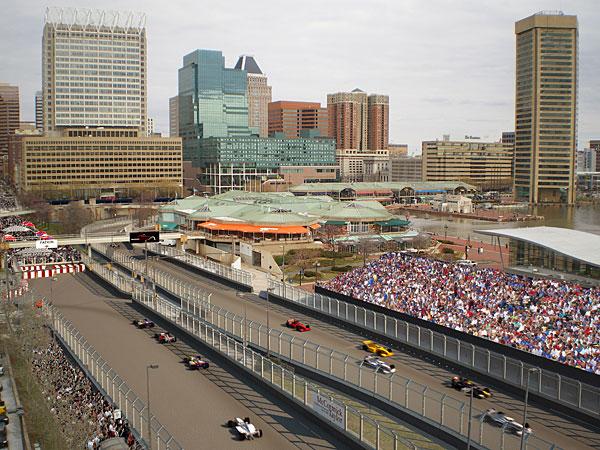Baltimore hopes for tourism boost from inaugural auto race
 |
 |
Construction for the Baltimore Grand Prix has been snarling downtown traffic all summer, but in a few weeks race cars will be flying along downtown streets at 180 mph on the newly paved temporary circuit.
The 2-mile, 13-turn course is taking shape as crews set up grandstands and cement walls topped by fences. Drivers will hurtle past the Inner Harbor, around Oriole Park at Camden Yards and down a main boulevard.
Baltimore has become known for crime dramas set in the city such as The Wire and Homicide, but this event will give the world another reference, said Councilman William Cole, whose district includes the circuit and surrounding neighborhoods.
"We're exposing the city to a completely new set of people, a new audience," he said. "To me that's the biggest motivation. We're changing the way people see Baltimore."
The IZOD IndyCar Series and the American Le Mans Series are headlining the three-day event that will also feature races from three other leagues. Fans will be able to watch practice and qualifying on Friday, while the Le Mans race is set for Saturday afternoon and the IndyCar race will close out Sunday.
The event is expected to draw 100,000 people to what's billed as a festival of speed over Labor Day weekend, usually a sleepy time downtown. Instead of being one of the slowest weekends, organizers and local officials envision packed hotels, restaurants and tourist venues.
"It could make one of our weakest tourism weekends maybe one of our strongest all summer long," said Tom Noonan, president and CEO of Visit Baltimore, the city's tourism bureau. The event will also help promote the city to an audience around the world.
"It's a great, several-hour commercial for Baltimore," Noonan said.
The city expects to make $11 million from just hotel, parking and amusement taxes over the five-year contract with Baltimore Racing Development, and organizers say the event will have a $70 million impact on the region.
But University of Maryland, Baltimore County professor Dennis Coates, who specializes in sports economics, is not convinced the event will have the promised economic impact. Evidence from similar events around the country and the world shows that they're "oversold and way under-delivered," Coates said.
"If you think the goal of government is to convince people that they live in a quote-unquote world-class city – whatever that means – then it will probably be a success," he said. "Will people have a good time? No doubt about it. But in terms of actually creating jobs, creating a better business environment? No."
Staging this year's race will cost about $7 million to $10 million, but the endeavor has attracted more than $3 million in private investment, according to Baltimore Grand Prix and Baltimore Racing Development President Jay Davidson.
The Maryland Stadium Authority has spent $1.5 million to rehabilitate the parking lot along the warehouse side of the baseball stadium, which will be used as pit row. Organizers must repay a $500,000 loan from the Maryland Economic Development Corporation.
The city has spent about $7 million, mostly federal and state funds, on fixing up the roads along the course. Officials condensed several improvement projects that otherwise would have been completed over years into just months, said Jaime McDonald, deputy chief of the city Department of Transportation engineering and construction division.
But there are a few adaptations for the race course, McDonald said. The asphalt roads are smoother and are made with higher-quality material that's more durable than what is used in most city roads. And manholes along the circuit will now be bolted or welded down so the force of the passing race cars doesn't blow them off, he said.
The race has been in the works for more than three years, and organizers have spent months working with surrounding neighborhoods and businesses so they know what to expect. The neighborhoods will receive $100,000 for streetscape enhancements and cleanup efforts.
HarborWalk Townhouse Association President Nancy Notaro said she was impressed with preparations for security and traffic patterns shared at meetings months before the event.
"They've taken everything very seriously," she said.
Some businesses will move workers to alternate sites or have workers telecommute, especially on Friday. The federal court in Baltimore, which is right along the Pratt Street straightaway, and the University of Maryland Baltimore campus, which has sites throughout the downtown area, will close for four days.
"Yes, it shuts down the city but … it's shutting down the city for us to have a world-class event," Mayor Stephanie Rawlings-Blake said.
The business is driven by attendance and television ratings, so the size and strength of the Baltimore metropolitan area was a draw, Indy Racing League Commercial Division President Terry Angstadt said. The event will be the Indianapolis-based league's only event in the mid-Atlantic region, and its location downtown is a chance to bring racing right into a bustling urban area.
"You're taking your product to them rather than having them drive 20 to 30 miles outside a metropolitan area to a race track," he said.
The track design is expected to offer many opportunities for passing, making the races more exciting, he said.
The straightaway on Pratt Street is unusually wide for street courses, making passing easier as drivers approach the first corner at the Inner Harbor, driver Scott Dixon said during a recent visit to the city.
"That's what everyone is here to see," Dixon said. "You'll see great racing, not just follow the leader." Newark Advocate
